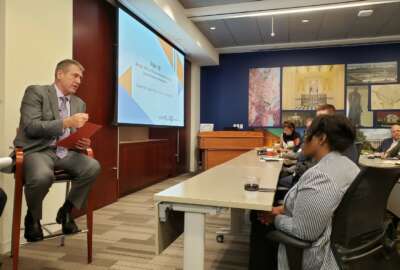

John Zangardi, CIO at the Department of Homeland Security, said his agency believes what’s best is “a hybrid, traditional on-premises and cloud IT approach.
For IT modernization in the federal government, the only consensus agencies can strike is on its importance. How to achieve this dream is still up for debate.
John Zangardi, chief information officer at the Department of Homeland Security, said his agency believes what’s best is “a hybrid, traditional on-premises and cloud IT approach that’s multi-cloud — meaning multiple cloud service providers, multiple infrastructure-as-a-service, platform-as-a-service and software-as-a-service providers.”
He told Federal News Network Executive Editor Jason Miller that the important thing for DHS to do now is look at where the agency has had success.
“Most recently, we completed consolidating down at [NASA’s John C.] Stennis Space Center — there’s a data center down there. We closed out two zones, Zones A and B,” he said on Federal Monthly Insights — A New Approach in IT Modernization. “Of those zones, we moved out 229 applications, 74 of those applications from DHS HQ, [Customs and Border Protection], [the Cybersecurity and Infrastructure Security Agency], [the Federal Protective Service], OneNet, [Transportation Security Administration], [U.S. Citizenship and Immigration Services] move to other parts of that data center. But from [Immigration and Customs Enforcement] 155 applications migrated to the cloud. Seventy-nine were in production, 145 of those were SharePoint sites.”
Zangardi said the big point to consider with cloud technology is the savings on hardware. ICE, for example, retired 853 pieces of hardware.
“So our focus right now is within the HQ organization,” Zangardi said on Federal Drive with Tom Temin. “I’m going to start with training, we’ve held two cloud stand-down days, where we’re doing online training. And the initial phase of this is to focus on creating a general understanding of what cloud offers to my workforce.”
The next phase will focus on the people executing the work, moving from what is essentially a level 101 course to a level 202 course and so on, he said. The penultimate phase entails focusing on the individuals who will deliver services and what precise training and/or certifications they need.
In a multi-cloud approach, Zangardi said his office provides standards to DHS agencies for how they must manage their components. As CIO, he said his main concern is accomplishing missions and securing the data that is put in the cloud.


“Because between now and then there’s a lot of work. And let’s not forget, the fiscal year is about to close out and there is, as you know from being around government for a long time, as you get to the end of the fiscal year, there’s a big bump in workload,” he said.
What’s also undecided is whether those managed services will be a government-owned, contractor-operated model, versus a contractor-owned, contractor-operated model.
“I think we need a little bit more time to flesh out the strategy and how we want to approach it,” Zangardi said. “But like I said, I’ve been through both, and I can see advantages to either. I think we just need time to think about the details.”
Copyright © 2024 Federal News Network. All rights reserved. This website is not intended for users located within the European Economic Area.
Amelia Brust is a digital editor at Federal News Network.
Follow @abrustWFED
